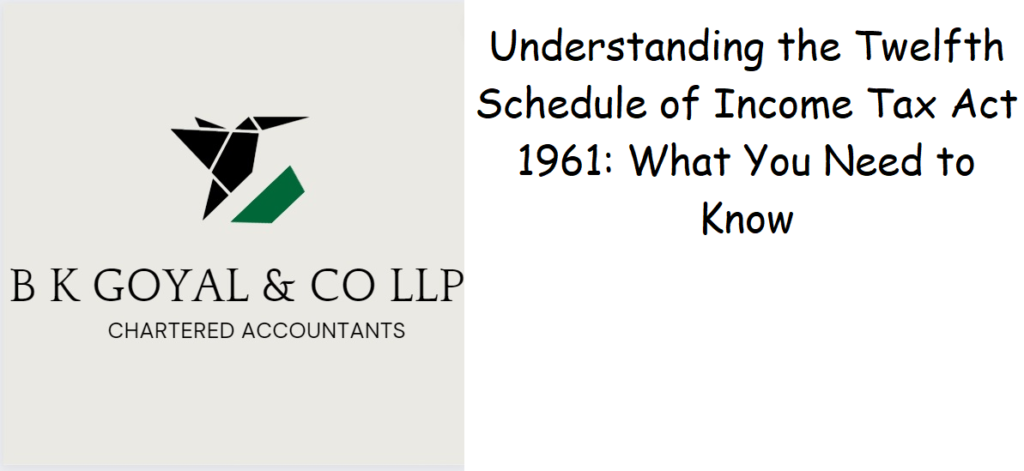Introduction
Are you looking to understand about Understanding the Twelfth Schedule of Income Tax Act 1961: What You Need to Know ?
This detailed article will tell you all about Understanding the Twelfth Schedule of Income Tax Act 1961: What You Need to Know.
Hi, my name is Shruti Goyal, I have been working in the field of Income Tax since 2011. I have a vast experience of filing income tax returns, accounting, tax advisory, tax consultancy, income tax provisions and tax planning.
The Twelfth Schedule of Income Tax Act 1961 is a crucial part of the Indian taxation system. It provides a detailed list of activities that qualify as ‘charitable purposes’ and are therefore eligible for tax exemptions. As per the Schedule, any income earned by charitable institutions is exempt from tax, subject to certain conditions. In this blog, we will explore the various aspects of the Twelfth Schedule of Income Tax Act 1961 and how it affects taxpayers.
Understanding the Twelfth Schedule of Income Tax Act 1961
The Twelfth Schedule of Income Tax Act 1961 lays down the various activities that are considered ‘charitable purposes’. These purposes are divided into various categories, including:
- Relief of the poor
- Education
- Medical relief
- Preservation of the environment (including watersheds, forests, and wildlife)
- Preservation of monuments and places of historical importance
- Advancement of any other object of general public utility
Each of these categories includes specific activities that qualify as charitable purposes. For example, under the category of ‘Relief of the poor’, activities like providing food, clothing, and shelter to the poor, or establishing schools or hospitals for the poor, qualify as charitable purposes.
The Twelfth Schedule also specifies that any income earned by a charitable institution that is used solely for charitable purposes is exempt from tax. However, the exemption is subject to certain conditions, such as:
- The institution should be registered under Section 12A of the Income Tax Act.
- The income should be applied solely for charitable purposes.
- The institution should maintain proper books of account and get them audited annually.
FAQs
Q. What is the purpose of the Twelfth Schedule of Income Tax Act 1961? A. The Twelfth Schedule of Income Tax Act 1961 provides a list of activities that qualify as ‘charitable purposes’ and are therefore eligible for tax exemptions.
Q. What are the categories of charitable purposes listed in the Twelfth Schedule? A. The categories of charitable purposes listed in the Twelfth Schedule include Relief of the poor, Education, Medical relief, Preservation of the environment, Preservation of monuments and places of historical importance, and Advancement of any other object of general public utility.
Q. Is all income earned by a charitable institution exempt from tax? A. No, only income earned by a charitable institution that is used solely for charitable purposes is exempt from tax.
Conclusion
In conclusion, the Twelfth Schedule of Income Tax Act 1961 is an essential part of the Indian taxation system. It provides a comprehensive list of activities that qualify as ‘charitable purposes’ and are therefore eligible for tax exemptions. As a taxpayer, it is essential to understand the various categories of charitable purposes listed in the Schedule and the conditions that need to be met to avail of tax exemptions. If you are associated with a charitable institution, it is important to ensure that it is registered under Section 12A of the Income Tax Act, and the income is used solely for charitable purposes.
The Twelfth Schedule, of Income Tax Act, 1961
The Twelfth Schedule, of Income Tax Act, 1961 states that
(i) Pulverised or micronised—barytes, calcite, steatite, pyrophyllite, wollastonite, zircon, bentonite, red or yellow oxide, red or yellow ochre, talc, quartz, feldspar, silica powder, garnet, sillimanite, fire clay, ball clay, manganese dioxide ore.
(ii) Processed or activated—bentonite, diatomaceous earth, fullers earth.
(iii) Processed—kaolin (china clay), whiting, calcium carbonate.
(iv) Beneficiated-chromite, fluorspar, graphite, vermiculite, ilmenite, brown ilmenite (lencoxene) rutile, monazite and other mineral concentrates.
(v) Mica blocks, mica splittings, mica condenser films, mica powder, micanite, silvered mica, punched mica, mica paper, mica tapes, mica flakes.
(vi) Exfoliated-vermiculite, calcined kyanite, magnesite, calcined magnesite, calcined alumina.
(vii) Sized iron ore processed by mechanical screening or crushing and screening through dry process or mechanical crushing, screening, washing and classification through wet process.
(viii) Iron ore concentrates processed through crushing, grinding or magnetic separation.
(ix) Agglomerated iron ore.
(x) Cut and polished minerals and rocks including cut and polished granite.
Explanation.—For the purposes of this Schedule, “processed”, in relation to any mineral or ore, means—
(a) dressing through mechanical means to obtain concentrates after removal of gangue and unwanted deleterious substances or through other means without altering the mineralogical identity;
(b) pulverisation, calcination or micronisation;
(c) agglomeration from fines;
(d) cutting and polishing;
(e) washing and levigation;
(f) beneficiation by mechanical crushing and screening through dry process;
(g) sizing by crushing, screening, washing and classification through wet process;
(h) other upgrading techniques such as removal of impurities through chemical treatment, refining by gravity separation, bleaching, floata-tion or filtration.

